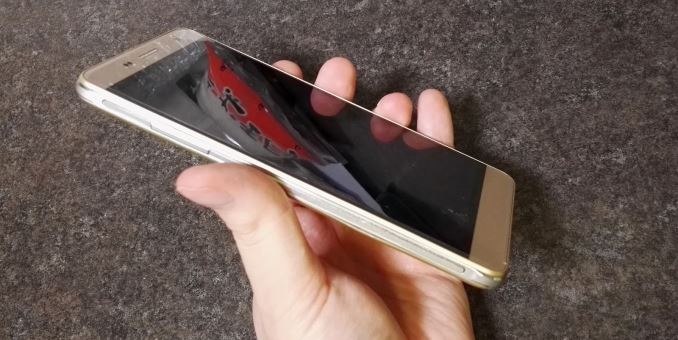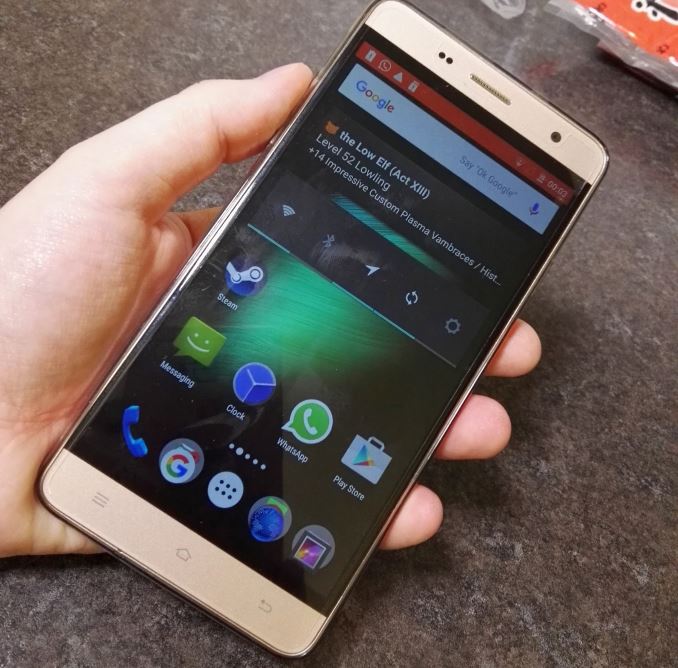The CUBOT H1 Smartphone Test: A Month with 3-4 Days of Battery per Charge
by Ian Cutress on December 23, 2015 9:01 AM EST- Posted in
- Smartphones
- Mobile
- Battery
- CUBOT
Final Words
I'll be brutally honest - while I keep a good tab on some elements of the smartphone market, more so on the business side, when it comes to deep dive analysis I leave it in the hands of Josh, Andrei and Brandon. That doesn't mean I don't need a device though, and despite their suggestions it seems I wanted a lot and wasn't prepared to spend the money. As a technical editor, my search for a smartphone caused a series of positive and negative feedback loops - some days I'd decide that DRAM was the most important, whereas others it would be the display resolution or the storage capacity. In the end it comes down to compromise and what is good and within range at the time I was looking. At one point I was adamant I wanted something more powerful than a Snapdragon 600 series, but I've ended up with a quad core MediaTek A53 device running at low frequency. There were some no-brainers – it had to be big enough and good enough to work on when I have short 20 minute public transport trips, and support dual SIM so I don’t have to keep losing my SIM card each time I travel.
The CUBOT H1 was the result of the search. It’s a smartphone that boasts 5200 mAh of battery, which is 3.4x the size of the battery in the iPhone 5c or 2x the battery in the Galaxy S6. When combined with the 1280x720 screen and the 1 GHz quad-core SoC, it gave 4 days of standard use battery which translated to 15 hours and 26 minutes on the PCMark battery test that runs from 100% to 20%, beating the Zenfone 2 by over nine hours. That is pretty much pre-2000 smartphone territory, more akin to what we used to have when playing games like Snake.
My smartphone use case has adapted over time – I want it to do work on. That means writing, switching between apps, being somewhat responsive, and always being available. The SoC means it doesn’t break any sort of record for performance, but ultimately so much of my use doesn’t require performance but rather latency in app switching and updates. Having enough memory to keep apps available means a lot, so moving up from 1GB to 2GB was a big enough change to notice, as well as the bump up to Android 5.1. The 16GB storage model is pretty basic, and the microSD compatibility is only at 32GB, rather than something bigger, and I know it will fill over time with the consistent photographing of my cats. But that is a risk that I’m going to have to take, or synchronize with Dropbox.
Without the silicone case that comes free with the phone, I will grant that despite the patterned edge, it does feel like the plastic the rear is made from, and arguably it slips out of the hand too easily. With the silicone case, it just feels like a smartphone with a case, which a lot of people use anyway. The raised power and volume buttons helps discern their location, and the fixed buttons is something I like to have on my device, even if it means giving up screen real estate.
It is clear that the cameras are not for taking glamour shots. But at a trade show, as long as you are in the front row, and have a second or two between shots, taking pictures of slides to work on later is good enough. To get a good shot taking advantage of the EIS though, you really need to use the burst mode which supports 40 shots at 13 MP each. The video is also an afterthought. That comes down to the price and what needs to be cut to meet that price. I purchased the device, brand new from Amazon, for £125 which translates to $160 pre-tax. Almost everyone I showed the phone to, probably due to the battery life argument, thought it was more expensive. The only people who guessed under (and only by $10) were a pair of senior ARM employees. But truth be told, I could buy four of these a year and it would still be cheaper than an S6. Of course, there are obvious caveats with that comparison.
I would say that this is going to be my phone for the next two years. But since I purchased it in October, two extra high end smartphones that others at AnandTech have tested have both landed on my desk for similar experiential testing. It almost seems sad to shelve the Cubot H1 immediately unless I adapt to carry two phones at once, with the H1 as that long-battery backup.
| CUBOT H1 | ||
| SoC | Mediatek MT6735P 4x ARM Cortex-A53 at 977 MHz ARM Mali-T720 MP2 at 400 MHz |
|
| RAM | 2GB LPDDR3 at 533 MHz | |
| Storage | 16GB NAND | |
| Display | 5.5” 720p IPS | |
| Modem | 2G / 3G / 4G LTE UE Category 4 DC-HSPA+, TD-SCDMA, CDMA2000 1x/EVDO Rev. A, EDGE |
|
| Networks |
TDD LTE | None |
| FDD LTE | B1 / B3 / B7 / B20 | |
| UMTS | 900 / 1900 / 2100 | |
| GSM | 850 / 900 / 1800 / 1900 | |
| Dimensions | 154.5 (h) x 76.6 (w) x 9.2 (d) mm, 201 grams* Weight Measured by AnandTech, conflicting numbers online |
|
| Cameras | Rear | 12.8MP ( 4128 x 3096 ) |
| Front | 8MP ( 3264 x 2448 ) | |
| Battery | 5200 mAh (19.76 Whr) | |
| OS | Android 5.1 | |
| Connectivity | 802.11a/b/g/n 2.4GHz BT 4.0, GPS, A-GPS, Micro-USB |
|
| SIM Size | Micro-SIM (FDD-LTE, WCDMA, GSM) Nano-SIM (GSM Only) Also Separate MicroSD slot, up to 32GB |
|
| MSRP (UK) | 16GB | $160
£125 as purchased |
So the final question becomes ‘how is it pronounced?’ Do we say cue-bot? Or perhaps cub-bot, or cue-bow? After writing this review, and looking at their online ‘CUBOT enterprise propaganda film’ on YouTube, it turns out to be coo-bot.












116 Comments
View All Comments
Ethos Evoss - Sunday, December 27, 2015 - link
And nobody from here commentary ppl will buy thisjabber - Monday, December 28, 2015 - link
I have the LG G4 and run it totally stock. If you don't use it like a Gameboy and interact with people like a normal human being you can get 2-3 days+ out of it easy.I don't get folks who can spend 5+ hours a day looking at their phone. Get a job, some friends or a real hobby!
phoenix_rizzen - Tuesday, December 29, 2015 - link
If I put my LG G2 into airplane mode and stuff it into a drawer, I can get several weeks out of a single battery charge.Why spend money on something you won't use? What's the point of having a 1440p screen if you never use it? If all you need is something to make voice calls on ... then why spend the money on a G4? You'd get better service out of a flip phone ... and better battery life to boot.
I don't get folks who spend $500+ CDN on a flagship smartphone ... and then never use it for anything but voice calls.
adriangb - Tuesday, December 29, 2015 - link
Very nice review. I suffer every day from my phone's (OnePlus 2) battery life, and while I think the industry has realized this is a major problem now (hopefully Qualcomm's 820 will aid in this respect), for now larger batteries are a nice solution.I would GLADLY drop $400 on a phone with a large battery/efficient SOC combo that gets me 5h+ SOT, granted the camera, screen and software stack up to the likes of $300 phones like OnePlus and Moto's. If anyone knows of this mythical device, please chime in.
phoenix_rizzen - Tuesday, December 29, 2015 - link
LG G2. You can still pick them up new, and they're only around $200 US. So long as you aren't a heavy gamer, gettting 5+ hours of SoT is easy. I've cross the 7 hour mark using mine for mostly Facebook and Kindle/Kobo reading.Although, now that the battery is 2 years old, I tend to only get 3 hours of SoT (I also do a lot more gaming and less reading on my phone these days).
JimmiG - Friday, January 8, 2016 - link
I didn't manage to get more than ~4h of SoT with my LG G2. Still better than most smartphones I've used. My current OnePlus One tops out at around 3h 30m. The best one was probably my Galaxy S3 with the original Samsung extended battery.Battery life will definitely be a top priority when I buy a new phone the next time.
Badelhas - Tuesday, December 29, 2015 - link
Great budget option indeed. But what is the OS version on this smarphone?p51d007 - Wednesday, December 30, 2015 - link
I've been using a Huawei Ascend Mate2 for the past 1 1/2 years. SD400, 6.1" screen, 4,050mAH battery. 2-3 days per charge. I'm not a gamer, but I do a lot of phone, web, text, mp3's, video etc.It's screen is sharp & clear, snappy, no lag. Best $300 I spent in a long time, and now it has an even better price.
ktkps - Thursday, December 31, 2015 - link
What about comparison with lenovo Vibe P1?Mugur - Monday, January 4, 2016 - link
For the same amount of money I would probably went with a Lumia 640 XL... Anyway, nice review from Ian. I like those "down to Earth" reviews, although, in this case I feel than the phone is a downgrade from a One Max (with the exception of the battery life - but Max also has an above average battery life). BTW, One Max has 2 GB/16 GB or 2 GB/32 GB, so it must be a mistake from Ian's part when he said something about 1 GB...I'm also a big fan of battery life and dual SIM (although I went last August from a Sony Xperia T2 Ultra Dual to a Samsung S6 Dual :-) ). Sony's 6" 720p screen was great and battery life was 3-3.5 days for me always - what killed the experience for me was its 1 GB of RAM and 8 GB of storage...
I spent a couple of months last year looking for the same thing Ian was searching for and I took into consideration a lot of factors and reviews. I only went with an S6 dual SIM because I wasn't able to find something like the T2 Ultra I had but with 2-3 GB of RAM, 16/32 GB of flash and (upgradeable to) Android 5.1.1. Note 5 or Edge+ dual SIM weren't available at that time (and when they were, the price in my country were 30% or more over that of the S6 dual SIM - not to mention that I payed for the S6 more that I was planning initially to spend on a phone).
All in all, I believe that there are a lot of other (better) options in my opinion, that what Ian choose. Probably a bit more expensive, but not by much.